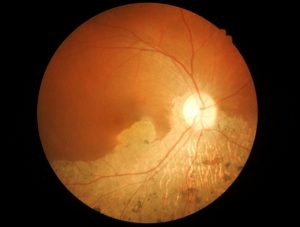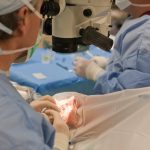 Macular hole is an eye condition that typically appears in people over the age of 60, but it is not the same as the much talked about eye disorder macular degeneration. It’s important to understand what makes them different, especially if you have a family history of eye problems.
Macular hole is an eye condition that typically appears in people over the age of 60, but it is not the same as the much talked about eye disorder macular degeneration. It’s important to understand what makes them different, especially if you have a family history of eye problems.
The macula is a part of the eye that is located at the center of the retina. A macular hole is a very tiny spot in the retina. When people develop a macular hole they can notice a sudden decrease in vision in one eye. Normally, light focuses to a sharp point at the macula. This is what enables us to see clear to drive, read, work on a computer, and recognize faces. A macular hole jeopardizes this ability.
Advertisement
There are different macular hole stages. In the early stages, macular hole causes distorted or blurred vision. In later stages, the hole can lead to extreme vision loss while peripheral vision remains.
Although macular hole is not the same as macular degeneration, it does happen for the most part due to aging. With macular degeneration, it is not just age related. It can be genetic, with factors such as race, gender, obesity, and sun exposure making the risk even higher. With macular degeneration, we know that the pigmentary cells in the macula actually begin to deteriorate. Cellular debris build up, blood vessels grow and leak fluid, thus impacting vision. Some people have minor vision loss with macular degeneration, while others experience complete vision loss.
Causes and risk factors for macular hole
The macular hole is more common in women and, as mentioned above, in older people. While age is the biggest factor, there are other risk factors, such as a history of a retinal tear or detachment, diabetes, retinal venous occlusions, and inflammation in the eye.
Macular hole causes vary from person to person. Many cases develop without any specific reason. This can be distressing, particularly when statistics show that once you have had a hole in one eye, there is a five to 15 percent chance of developing a macular hole in the other eye.
Here are some situations that could lead to macular hole formation:
- Vitreous traction: the natural eye gel that fills up the inside of the eye shrinks and pulls away from the retina, creating a hole.
- Injury or trauma: macular holes can form following blunt force trauma.
- Diabetes: diabetic eye disease can lead to macular holes.
- High degree of myopia (nearsightedness).
- Macular pucker: scar tissues over the macula that contract.
Signs and symptoms of macular hole
 Macular hole symptoms are not always obvious, but in a lot of cases central vision does become distorted or blurred. If the hole progresses, a blind spot can develop in your central vision, impairing your ability to see at a distant and at close range.
Macular hole symptoms are not always obvious, but in a lot of cases central vision does become distorted or blurred. If the hole progresses, a blind spot can develop in your central vision, impairing your ability to see at a distant and at close range.
Macular hole symptoms typically include a decreased ability to see fine details when looking at something directly, vision distortion that is similar to looking through thick fog, and the possibility of a dark or blind spot in the center of your field of vision. If your macula is damaged, you will not lose your entire vision. Most likely, you will still have peripheral or side vision.
Difference between macular hole and macular degeneration
We all have a gel-like substance in our eyes called the vitreous gel. While we have established that macular hole can develop from injury or another disease such as diabetes, the most common reason for macular hole is aging. Research indicates that aging changes the vitreous gel, which fills the back cavity of the eye. This gel substance is attached to the retina with tiny fibers. As we get older, the vitreous gel can turn to liquid, shrink, and contract. When this happens, it pulls away from the retina and creates a tear or hole.
With macular degeneration, pigmentary cells in the macula start to weaken. As a result, debris build up, leading to drusen, which are yellow deposits under the retina. Any fragile blood vessels then begin to grow, and leak blood and fluid. At this point, vision begins to degrade.
Treatment options for macular hole
 Macular hole stages often give people a better idea of how to address their eye concerns.
Macular hole stages often give people a better idea of how to address their eye concerns.
- Foveal detachments: 50 percent of cases will get worse without treatment
- Partial-thickness holes: 70 percent of cases will get worse without treatment
- Full-thickness holes: majority of cases will get worse without treatment
A macular hole can resolve itself without treatment, but in most cases, treatment of some kind is required to prevent permanent vision loss. Vitrectomy surgery is considered the most effective treatment to repair macular holes. A surgeon will use a tiny instrument to remove the vitreous gel pulling on the macula. The eye is then filled with a special gas or oil to flatten the macular hole and hold tissues in place until the eye heals. As the macular hole closes, the eye should regain some or all of the lost sight.
Complications of macular hole surgery
Macular hole surgery comes with complications. Operations involving the vitreous have the potential to lead to infections and retinal detachment. On the upside, both of these complications are treatable. The most common risk with macular hole surgery is the development of cataracts. They can also be removed once the eye has healed from the vitrectomy.
People who have macular hole surgery using a gas bubble are not able to travel by air for several months following the procedure. This is due to the fact that the gas can expand with changes in air pressure, causing eye damage.
Advertisement
When someone has had a macular hole for less than a year, there is a 90 percent chance that surgery will be successful in closing the hole. About 70 percent of those successfully treated will be able to read two or three additional lines on a vision chart, compared to their results before the surgery. Some people who have the surgery but continue to lose central vision can have a second operation to attempt to close the hole.
There are some cases of macular hole that can be treated with an injection of a substance called, ocriplasmin. This injection helps the vitreous gel separate from the back of the eye so that the hole closes. Injections have proven to be successful in closing a macular hole in about 40 percent of cases.
Having any kind of vision impairment can be scary. Some eye problems can be more serious than others. If you or someone you know has any of the symptoms mentioned here, it’s important that you don’t jump to conclusions. While macular hole is possible, there is also a chance that it could be some other eye condition. As soon as an eye concern pops up, you should make an appointment with a qualified eye specialist. In most cases, the sooner the problem is addressed, the better chance you have of preserving your vision.
